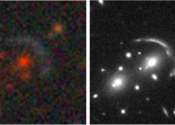Students discover bright lensed galaxy in the early universe
The night sky is a natural time machine, used by cosmologists to explore the origins and evolution of the universe. Reaching into the depths of the past, a class of undergraduate students at the University of Chicago sought ...









